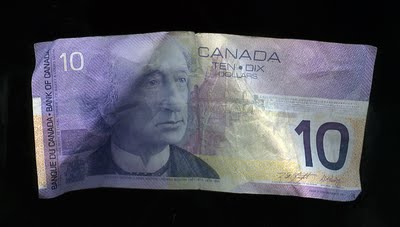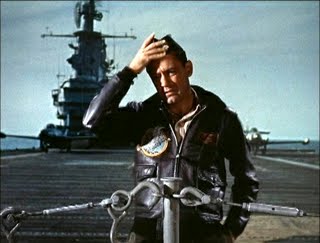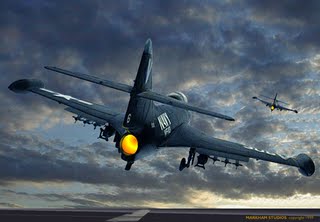
Lt. Harry Brubaker: I’m a lawyer from Denver, Colorado.
Mike Forner: Judas, how'd you wind up in a smelly ditch in Korea?
Lt. Harry Brubaker: I was just asking myself that same question.
Bridges at Toko-Ri, 1954

I have much more time in my hands these days and instead of using it to read, to file photographs or perhaps find a way of fixing the ancient plumbing of our house I have been spending it in self-reflection. I have been observing the world around me and how I have changed (or not changed) in relation to it.
A little incident at the downtown coffee shop on lower Granville Street, Trees Organic Coffee, yesteday, brought lots of that self-reflection, nostalgia and memories of my past.
It was sometime around 1948 or 1949 (I was 6 or 7) when I accompanied my mother to a nearby ferretería (hardware store) on Hahuel Huapí Street around the corner from our house on Melián in Buenos Aires. There was something that I wanted and my mother pulled a very red and crisp peso bill (I think it was a ten peso one). She stretched it out and said to me, “Alex, what you want would take one of these and it is much too much money. I will not buy this for you until you learn the value of money.” I really did not have much of an idea of what money was and much less its value so my mother’s exercise in frugality was one I did not understand. I can still remember the sharp snap the bill made when she stretched it.
At Trees I offered to pay for my coffee and Bob Mercer’s (an ex editor but still friend of mine) mate. I produced a ten dollar bill and gave it to the cashier. Just like my mother had done in BA she held it by its sides and she stretched it out. I heard the snap. Then she told me, “This is a fake bill. Do you have another one?” I didn’t so Mercer paid. I felt saddened by the sudden loss of my ten dollars. Mercer tried to console me by explaining, “What you have in your pocket is a Canadian three-dollar bill. You see I paid the five fifty and added a tip to make it seven. Since you were going to pay for it, all you have really lost is the bill you have in your pocket which is now worth three dollars.”
I went home saddened by the event. As I struggle with the financially unstable profession of photography I have come to the conclusion that 61 years have elapsed since my mother told me I had to learn the value of money. It seems that not only have I yet to understand its value but I cannot even tell the real thing when I see it.
But not all was lost. I turned on the TV and Robert Osborne, the evening host of Turner Classics Movies, was announcing the next feature. It was the 1954 Mark Robson film, The Bridges at Toko-Ri with William Holden, Grace Kelly, Mickey Rooney and Frederick March.
The first and last time I had seen it was in 1955. I had been completely infatuated with Grace Kelly. I had been depressed by its grim, un-Hollywood ending. Even then, the film seemed bleak and the moments with Grace Kelly, too short.
I am happy to report that in this second viewing the film is grittier, it seems even more authentic and it is far bleaker than I had imagined it. The brilliant young lawyer, William Holden (married to Grace Kelly and the father of two beautiful little girls) was an efficient WWII navy flier who suddenly finds himself, a recalled naval reservist who has to fly (Grumman Panther jets) over the then misunderstood "police action" (the word war was never used at the time) in Korea. Holden is befriended by his carrier admiral, the father figure Frederick March, who adopts Holden in place of the two sons he lost in the previous war.
Until the end of the film you never get a glimpse of the enemy. The bombing and the strafing does not include enemy aircraft and the demolition of the bridges of the story does not show its human element. It would seem that by 1954 there was already a foreboding of future wars - a war where you pressed buttons to cause surgically sterile death and destruction. The beautiful dark blue F9F Panthers prefigured the idea of sending lone drones over Pakistan and southern Afghanistan.
Both the film version and James Michener’s book, end in a stinking irrigation farm ditch in North Korea. The pilot (Holden’s plane loses its fuel in a flak hit over the secondary bombing of an ammunition dump) and his would-be helicopter rescuers die in the mud as they are besieged the appearance of the enemy at last. The soldiers, who obviously do not plan to take prisoners shoot them. The film ends there and I immediately thought that the descendants of those soldiers are putting together Hyundais and LED TV flat screen TVs.
The Bridges at Toko-Ri, released two years after the first real adult western, High Noon, is in my mind the first real (American, at least) adult war film. It is a film that resonates more today that it did then. This is so because the “missions” of Afghanistan could be better equated to the “police action” of Korea and not to that war in Vietnam. In both Korea and in Afghanistan the ditches seem to be as real, as pointless and as grim.
When Holden questions Frederick March as to why he (the pilot) is fighting a war (that his wife does not understand), March answers, "It's a matter of distance; we do this because we're here; back home they're only doing just as you would be doing if you were there."

Just for a few minutes as I finished here I realized that the colour of those Panthers in The Bridges at Toko-Ri is the same colour as my favourite melancholy jazz album, Miles Davis’ Kind of Blue. Both the film and the album depress me. But it is a depression that leads to self-reflection and that is not entirely bad.






